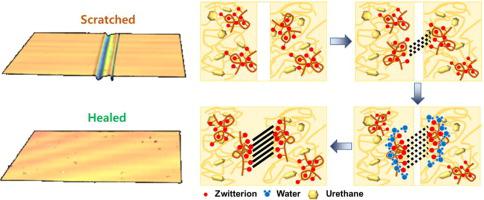Chemical Engineering Journal ( IF 15.1 ) Pub Date : 2020-11-06 , DOI: 10.1016/j.cej.2020.127636 Jungsoon Kang , Jinsil Kim , Kiwon Choi , Pyong Hwa Hong , Hee Jeong Park , Kiseung Kim , Young Kyung Kim , Gyeongmin Moon , Hyeryeon Jeon , Seoyun Lee , Min Jae Ko , Sung Woo Hong

|
In this study, the synthesis of a water-triggered highly self-healable elastomer with excellent optical and mechanical properties through localized zwitterionic assemblies is demonstrated for the first time using a newly proposed blending method. The self-healable elastomer obtained by blending conventional polyol and zwitterionic polyol shows a high transmittance (∼92%) and low yellow index value (1.9). The fabricated material with localized zwitterionic clusters shows superior self-healing efficiency (94–100%) under both dry and wet conditions compared with conventional nonionic elastomers (∼69%) and ionic elastomers with randomly distributed ions (80–87%). This is attributed to the significantly higher probability of contact between the localized zwitterionic assemblies of this material in the damaged area. More importantly, conventional self-healing materials have obtained the self-healing properties of polymers at the expense of their mechanical properties. An elastomer with localized zwitterions eliminates this trade-off between self-healing and mechanical properties. These properties are attributed to the unique intermolecular network resulting from strong interactions between localized zwitterionic clusters. As a result, the zwitterionic self-healable elastomer, based on the blending system proposed in this study, can maximize its self-healing capabilities and overcome the limitations of conventional self-healing materials via the concentration of zwitterions into a local domain.
中文翻译:

使用局部两性离子组件实现水触发的高度自修复的弹性体,具有增强的机械性能
在这项研究中,首次使用新提出的共混方法论证了通过局部两性离子组合物合成水触发的具有良好光学和机械性能的高自修复弹性体的方法。通过将常规多元醇和两性离子多元醇混合获得的自修复弹性体显示出高透射率(〜92%)和低黄指数(1.9)。与传统的非离子弹性体(〜69%)和具有随机分布离子的离子弹性体(80-87%)相比,具有局部性两性离子簇的预制材料在干燥和湿润条件下均表现出优异的自愈效率(94-100%)。这归因于该材料的局部两性离子组装体在受损区域之间接触的可能性更高。更重要的是,常规的自修复材料以其机械性能为代价获得了聚合物的自修复性能。具有局部两性离子的弹性体消除了自愈和机械性能之间的折衷。这些特性归因于局部两性离子簇之间的强相互作用所产生的独特分子间网络。结果,基于本研究中提出的共混体系的两性离子自修复弹性体可以通过将两性离子集中到局部区域来最大化其自修复能力,并克服传统自修复材料的局限性。具有局部两性离子的弹性体消除了自愈和机械性能之间的折衷。这些特性归因于局部两性离子簇之间的强相互作用所产生的独特分子间网络。因此,基于本研究中提出的共混体系的两性离子自修复弹性体可以通过将两性离子集中到局部区域来最大化其自修复能力,并克服传统自修复材料的局限性。具有局部两性离子的弹性体消除了自愈和机械性能之间的折衷。这些特性归因于局部两性离子簇之间的强相互作用所产生的独特分子间网络。因此,基于本研究中提出的共混体系的两性离子自修复弹性体可以通过将两性离子集中到局部区域来最大化其自修复能力,并克服传统自修复材料的局限性。


























 京公网安备 11010802027423号
京公网安备 11010802027423号